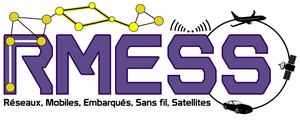Impact of intra-flow network coding on the relay channel performance: an analytical study
Résumé
One of the most powerful ways to achieve trans- mission reliability over wireless links is to employ efficient coding techniques. This paper investigates the performance of a transmission over a relay channel where information is protected by two layers of coding. In the first layer, transmission reliability is ensured by fountain coding at the source. The second layer incorporates network coding at the relay node. Thus, fountain coded packets are re-encoded at the relay in order to increase packet diversity and reduce energy consumption. Performance of the transmission is measured by the total number of trans- missions needed until the message is successfully decoded at the destination. We show through both analytical derivations and simulations that adding network coding capabilities at the relay optimizes system resource consumption. When the source uses a random linear fountain code, the proposed two-layer encoding becomes more powerful as it reduces the transmission rate over the direct link between the source and the destination.
Origine : Fichiers produits par l'(les) auteur(s)
Loading...
